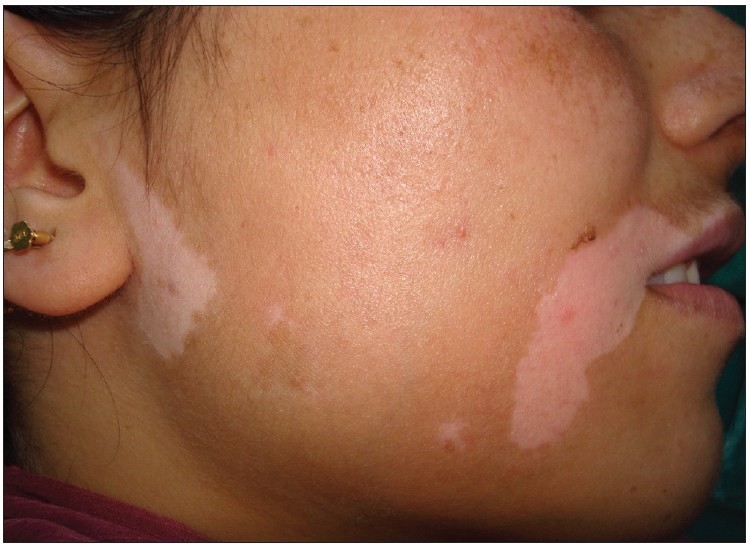Playlist
Show Playlist
Hide Playlist
Vitiligo in Darker Skin: Epidemiology and Presentation
-
Slides Vitiligo in Darker Skin Epidemiology Presentation.pdf
-
Download Lecture Overview
00:01 Welcome to our lecture on vitiligo. 00:04 Vitiligo is a progressive skin condition in which there is destruction of melanocytes, resulting in the loss of skin pigmentation. 00:16 The prevalence of vitiligo in the general population ranges between 0.1 to 2%. 00:24 It affects both children and adults, and there is an equal incidence in males and females. There is no racial or ethnic predilection. 00:35 The etiology of vitiligo is multifactorial. 00:41 Genetic predisposition has also been implicated, with 50% of affected individuals having a family history of vitiligo. 00:55 20% of affected individuals have an autoimmune condition, for example, Hashimoto's thyroiditis, Graves' disease, t ype 1 diabetes mellitus, and Addison's disease. 01:09 Research has shown that Covid and injections as a new cause of acquired vitiligo. 01:19 Vitiligo presents as a sharply demarcated macules or patches. 01:23 Some are milky or chalk white in color, depending on the skin color. 01:27 In black patients, you can have multiple clinical presentations. 01:34 It can present with trichromatic lesions, that is, hypo hyperpigmented and deep pigmented lesions, and in black patients, vitiligo is quite conspicuous because of the clear demarcation between the depigmented skin and the dark skin, whereas in white skin vitiligo is not so conspicuous. 01:57 So it stands to reason that black patients with vitiligo have a decreased quality of life compared to lighter skinned patients. 02:07 The sites that are commonly involved are the face, mouth, genitalia, elbows, ahandnd s. 02:12 So we want to talk now about the different types of vitiligo. 02:17 The first one being non-segmental vitiligo and under non-segmental vitiligo we've got the following types from generalized to vitiligo minor or hypochromic vitiligo. 02:31 Focusing on generalized vitiligo, one gets depigmented macules randomly distributed over the body surface area, and this tends to commonly occur on the face, trunk, and extremities. Vitiligo may start in childhood or sometimes in early adulthood. 02:51 The second type, which is acrofacial or acral vitiligo. 02:56 The patient may present with depigmented macules confined to the distal extremities and/or face. 03:03 It may later spread to other body sites besides the acral areas. 03:08 Mucosal vitiligo involves the oral and genital areas. 03:15 It may occur in the context of generalized vitiligo or is an isolated manifestation. 03:21 Sometimes patients with mucosal vitiligo, particularly the lips, may be mistaken as patients who have rubella sign, which is what one sees in patients with alcoholism because of the depigmented lower lip, and this can actually affect the patients because they often mislabeled as being heavy drinkers when in actual fact they have mucosal vitiligo. 03:47 Universal vitiligo is another type of vitiligo where you get complete or nearly complete skin depigmentation. Some skin areas and hairs may be partially spared and sometimes may have leukoplakia, leuko referring to white hairs. 04:05 Vitiligo, minor or hypochromic vitiligo is a next type of vitiligo. 04:10 There's incomplete loss of pigmentation and it results in paler areas of skin compared to the surrounding skin. It is much more common in individuals with darkly pigmented skin. 04:23 The last type segment al vitiligo occurs in a dermatomal or quasi -dermatomal pattern, meaning there may be multiple dermatomes that are involved, and segmental vitiligo tends to have a better prognosis. 04:38 It typically occurs along the distribution of the trigeminal nerve, or it can occur on other dermatomes and it's the least common type. 04:48 The areas of depigmentation usually stabilize within a year, and rarely does it spread beyond the affected dermatome.
About the Lecture
The lecture Vitiligo in Darker Skin: Epidemiology and Presentation by Ncoza Dlova is from the course Hyper- and Hypopigmentation Skin Disorders.
Included Quiz Questions
What is the approximate prevalence of vitiligo in the general population?
- 0.1% to 2%
- 1% to 10%
- 0.5% to 5%
- 0.01% to 0.1%
- >10%
What percentage of vitiligo patients have a concurrent autoimmune condition?
- 20%
- 50%
- 10%
- 35%
- 75%
Which type of vitiligo typically stabilizes within one year and rarely spreads beyond the affected area?
- Segmental vitiligo
- Universal vitiligo
- Acrofacial vitiligo
- Mucosal vitiligo
- Generalized vitiligo
Customer reviews
5,0 of 5 stars
| 5 Stars |
|
5 |
| 4 Stars |
|
0 |
| 3 Stars |
|
0 |
| 2 Stars |
|
0 |
| 1 Star |
|
0 |




